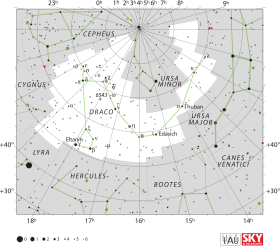Pi Draconis (π Draconis / π Dra) est une étoile de la constellation circumpolaire boréale du Dragon . Elle est visible à l’œil nu avec une magnitude apparente de 4,59[ 2] années-lumière étoile géante blanche riche en métaux .
Environnement stellaire
Pi Draconis présente une parallaxe annuelle de 14,25 mas mesurée par le satellite Hipparcos [ 1] a.l. pc extinction créé par la poussière interstellaire présente sur le trajet de sa lumière jusqu'à la Terre[ 12]
C'est une étoile solitaire, qui ne possède pas de compagnon connu[ 7] , [ 4]
Pi Draconis est une géante blanche de type spectral A2 IIIs [ 3] , [ 4] [ 7] classe de luminosité d'étoile géante « III spectre montre des raies d'absorption étroites (s pour sharp
Il s'agit d'une étoile Am candidate[ 9] particularités chimiques . Sa métallicité , c'est-à-dire son abondance des éléments plus lourds que l'hélium est environ 2,6 fois supérieure à celle du Soleil[ 6]
Pi Draconis a une taille angulaire mesurée de 0,427 ± 0,062 seconde d'arc [ 12] supérieur à celui du Soleil [ 8] massive et 60 fois plus lumineuse que le Soleil [ 10] température de surface est de 9 125 K [ 9]
↑ a b c d e et f (en) F. van Leeuwen , « Validation of the new Hipparcos reduction », Astronomy & Astrophysics vol. 474, no 2, novembre 2007 , p. 653–664 (DOI 10.1051/0004-6361:20078357 Bibcode 2007A&A...474..653V arXiv 0708.1752 ↑ a b c et d (en) H. L. Johnson et al. UBVRIJKL photometry of the bright stars », Communications of the Lunar and Planetary Laboratory vol. 4, no 99, 1966 (Bibcode 1966CoLPL...4...99J ↑ a b et c (en) F. Royer et al. Rotational velocities of A-type stars in the northern hemisphere. II. Measurement of v sin i », Astronomy & Astrophysics vol. 393, octobre 2002 , p. 897–911 (DOI 10.1051/0004-6361:20020943 Bibcode 2002A&A...393..897R arXiv astro-ph/0205255 ↑ a b et c (en) P. P. Eggleton et A. A. Tokovinin , « A catalogue of multiplicity among bright stellar systems », Monthly Notices of the Royal Astronomical Society vol. 389, no 2, septembre 2008 , p. 869–879 (DOI 10.1111/j.1365-2966.2008.13596.x Bibcode 2008MNRAS.389..869E arXiv 0806.2878 ↑ (en) G. A. Gontcharov , « Pulkovo Compilation of Radial Velocities for 35 495 Hipparcos stars in a common system », Astronomy Letters vol. 32, no 11, novembre 2006 , p. 759 (DOI 10.1134/S1063773706110065 Bibcode 2006AstL...32..759G arXiv 1606.08053 ↑ a b et c (en) E. Anderson et Ch. Francis , « XHIP: An extended Hipparcos compilation », Astronomy Letters vol. 38, no 5, mai 2012 , p. 331 (DOI 10.1134/S1063773712050015 Bibcode 2012AstL...38..331A arXiv 1108.4971 ↑ a b c et d (en) R. J. De Rosa et al. The VAST Survey - III. The multiplicity of A-type stars within 75 pc », Monthly Notices of the Royal Astronomical Society vol. 437, no 2, janvier 2014 , p. 1216–1240 (DOI 10.1093/mnras/stt1932 Bibcode 2014MNRAS.437.1216D arXiv 1311.7141 ↑ a et b (en) Kenneth R. Lang , Astrophysical formulae , vol. 1, Berlin, Birkhäuser , coll. « Astronomy & Astrophysics 2006 , 3e éd. (ISBN 3-540-29692-1 lire en ligne ) R ☉ ) est donné par la formule suivante :
2
⋅
R
∗
=
(
70.2
⋅
0.427
⋅
10
−
3
)
AU
0.0046491
AU
/
R
⨀
≈
6.4
⋅
R
⨀
{\displaystyle {\begin{aligned}2\cdot R_{*}&={\frac {(70.2\cdot 0.427\cdot 10^{-3})\ {\text{AU}}}{0.0046491\ {\text{AU}}/R_{\bigodot }}}\\&\approx 6.4\cdot R_{\bigodot }\end{aligned}}}
↑ a b c et d (en) Kutluay Yüce et Saul J. Adelman , « Elemental Abundance Analyses with DAO Spectrograms. XXXIV. A Three-Dimensional Graphical Examination of the Elemental Abundances of the Mercury-Manganese and Metallic-Line Stars », Publications of the Astronomical Society of the Pacific vol. 126, no 938, avril 2014 , p. 345 (DOI 10.1086/676335 Bibcode 2014PASP..126..345Y ↑ a et b (en) I. McDonald , A. A. Zijlstra et M. L. Boyer , « Fundamental Parameters and Infrared Excesses of Hipparcos Stars », Monthly Notices of the Royal Astronomical Society vol. 427, no 1, 2012 , p. 343–57 (DOI 10.1111/j.1365-2966.2012.21873.x Bibcode 2012MNRAS.427..343M arXiv 1208.2037 ↑ (en) * pi. Dra -- Star sur la base de données Simbad Centre de données astronomiques de Strasbourg .↑ a et b (en) Gerard T. van Belle et Kaspar von Braun , « Directly Determined Linear Radii and Effective Temperatures of Exoplanet Host Stars », The Astrophysical Journal vol. 694, no 2, 2009 , p. 1085–1098 (DOI 10.1088/0004-637X/694/2/1085 Bibcode 2009ApJ...694.1085V arXiv 0901.1206
Lien externe

